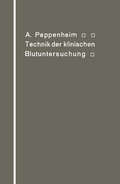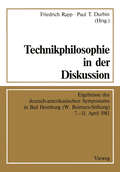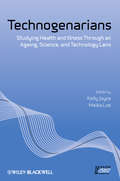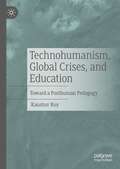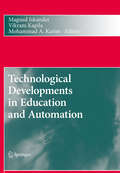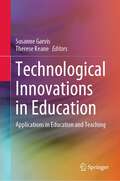- Table View
- List View
Technicians in Higher Education and Research: An Insight into Technical Careers, Roles and Contributions
by Kelly VereDedicated to the technical talent underpinning research, teaching and innovation within universities and research institutes, this book highlights the vital contributions of technicians to the higher education and research sector.Exploring the varied definitions of the technical role and recent developments in the professional landscape, this book brings together a diverse set of contributors who each discuss their unique, first-hand and authentic perspectives on this crucial community. Initial chapters cover the varied definitions of the technical role, explore the current demographics of this workforce and provide a history of the origins of the profession. The book continues to explore broad themes that are key components of the roles of the modern-day technician including teaching, research, leading core facilities, health and safety, procurement, environmental sustainability and research culture. It concludes by looking to the future and explores recent developments in the landscape for the technical community and the work underway to engage the public with technical roles and careers, challenging perceptions and stereotypes about the roles of technicians.Written in an accessible style, this essential volume shines a light on this understudied group to raise the profile of technical careers, roles and contributions, and to ensure sector-wide insights into this invisible workforce. It is a must-read for aspiring and current technicians across all disciplines, education and research leaders, managers and policymakers.
Technik – Kultur – Bildung: Analyse philosophischer Ansätze zum Technikbegriff im Hinblick auf eine Technische Allgemeinbildung
by Thomas-Hugo MöllersIn diesem Open-Access-Buch geht der Autor der Frage nach, warum Technik als wesentlicher Bestandteil der Kultur in der Bildung nur eine untergeordnete Bedeutung hat und begründet mit Hilfe technikphilosophischer Analysen einen Kulturreihenansatz für die Auswahl von Inhalten für den Technikunterricht. Aus dem Doppelauftrag von Schule, Persönlichkeitsbildung und Enkulturation wird zunächst ein Interaktionsmodell für Bildung und Erziehung abgeleitet. Das Problem der Inhaltsauswahl jeder Fachdidaktik wird mit einem Modell zur Verknüpfung von Allgemeiner Didaktik und Fachwissenschaften gelöst. Darin wird die Technikphilosophie als fehlende Bezugswissenschaft identifiziert, um Aussagen zum Wesen der Technik zu ermöglichen. Durch die Analyse technikphilosophischer Ansätze wird der Technikbegriff um eine ästhetische und eine Sinn- und Wertperspektive erweitert. Aus diesem Technikbegriff ergeben sich pädagogische Perspektiven für den Technikunterricht, die schließlich über einen Kulturreihenansatz zu einem Kern Technischer Allgemeinbildung führen. Durch den Kulturreihenansatz wird begründet umrissen, wie die kulturelle Bedeutung der Technik bildungswirksam werden kann.
Technik der klinischen Blutuntersuchung für Studierende und Ärzte
by A. PappenheimDieser Buchtitel ist Teil des Digitalisierungsprojekts Springer Book Archives mit Publikationen, die seit den Anfängen des Verlags von 1842 erschienen sind. Der Verlag stellt mit diesem Archiv Quellen für die historische wie auch die disziplingeschichtliche Forschung zur Verfügung, die jeweils im historischen Kontext betrachtet werden müssen. Dieser Titel erschien in der Zeit vor 1945 und wird daher in seiner zeittypischen politisch-ideologischen Ausrichtung vom Verlag nicht beworben.
Technikphilosophie in der Diskussion: Ergebnisse des deutsch-amerikanischen Symposiums in Bad Homburg (W. Reimers-Stiftung) 7.–11. April 1981
by Friedrich Rapp Paul T. DurbinThe Technique of Orchestration: Pearson New International Edition
by Kent Kennan Donald GranthamThe Technique of Orchestration, Seventh Edition, is the definitive textbook on the study of orchestration, offering a concise, straight-to-the-point approach that prepares students to score their own compositions with confidence. Updated to reflect developments in instruments and orchestral best practices, this seventh edition features: Copious musical examples spanning the history of the orchestra Detailed descriptions of instruments and their distinctive characteristics Explanations of how to score chords and transcribe piano idioms Discussions on specialized ensembles and scoring techniques New musical examples have been added throughout and listening lists have been revised to include more music by women and composers of color, representing a diverse musical catalogue. Supported by an accompanying workbook of scores and scoring exercises (available separately), as well as a robust listening program keyed to the textbook, The Technique of Orchestration, Seventh Edition, is an accessible, essential, all-in-one resource for the student of orchestration.
The Technique of Orchestration
by Kent Kennan Donald GranthamThe Technique of Orchestration, Seventh Edition, is the definitive textbook on the study of orchestration, offering a concise, straight-to-the-point approach that prepares students to score their own compositions with confidence. Updated to reflect developments in instruments and orchestral best practices, this seventh edition features: Copious musical examples spanning the history of the orchestra Detailed descriptions of instruments and their distinctive characteristics Explanations of how to score chords and transcribe piano idioms Discussions on specialized ensembles and scoring techniques New musical examples have been added throughout and listening lists have been revised to include more music by women and composers of color, representing a diverse musical catalogue. Supported by an accompanying workbook of scores and scoring exercises (available separately), as well as a robust listening program keyed to the textbook, The Technique of Orchestration, Seventh Edition, is an accessible, essential, all-in-one resource for the student of orchestration.
The Technique of Orchestration Workbook
by Kent Kennan Donald GranthamThe Technique of Orchestration Workbook, Seventh Edition, accompanies the textbook of the same name—the definitive resource on the study of orchestration—providing musical excerpts, full scores, and scoring assignments to enrich the lessons learned in the textbook. Spanning an array of periods and styles, the musical examples collected here cover scoring techniques in the following sections: Strings Woodwinds Brass Scoring of Chords Transcribing Piano Music Scoring for Woodwinds, Horns, and Strings Percussion Harp and Keyboard Instruments Scoring for Full Orchestra Additional learning tools include transposition exercises, error detection drills, and discussions on harmonics, while the workbook pages are perforated throughout for ease of use in and out of the classroom. Featuring the music of Bach, Mozart, Brahms, Beethoven, Schumann, Copland, Bartók, and many more, The Technique of Orchestration Workbook, Seventh Edition, is an invaluable companion to the textbook.
The Technique of Orchestration Workbook
by Kent Kennan Donald GranthamThe Technique of Orchestration Workbook, Seventh Edition, accompanies the textbook of the same name—the definitive resource on the study of orchestration—providing musical excerpts, full scores, and scoring assignments to enrich the lessons learned in the textbook. Spanning an array of periods and styles, the musical examples collected here cover scoring techniques in the following sections: Strings Woodwinds Brass Scoring of Chords Transcribing Piano Music Scoring for Woodwinds, Horns, and Strings Percussion Harp and Keyboard Instruments Scoring for Full Orchestra Additional learning tools include transposition exercises, error detection drills, and discussions on harmonics, while the workbook pages are perforated throughout for ease of use in and out of the classroom. Featuring the music of Bach, Mozart, Brahms, Beethoven, Schumann, Copland, Bartók, and many more, The Technique of Orchestration Workbook, Seventh Edition, is an invaluable companion to the textbook.
The Technique of Pencil Drawing
by Borough JohnsonOnly a thoroughly accomplished artist such as Borough Johnson--a nineteenth-century landscape and genre painter--could manage to illuminate the technique of pencil drawing in these exquisitely simple terms. Artists at every level of experience will appreciate the wealth of information he offers on everything from choosing the right tools to drawing the nude figure. With a host of helpful "how-to" illustrations, as well as a "mini-gallery" of finished compositions, this invaluable guide offers clear direction for artists who want to learn to draw--or sharpen their skills. Johnson starts with the basics, explaining how to hold a pencil for the greatest control, how to select the right paper, and how to add shading and tone for the best results. "The range of effects is infinite," he affirms. Moving outdoors, he tackles landscapes, seascapes, and other scenery, demonstrating where to start your sketch and where to leave off. When drawing the nude figure, he suggests quick poses to capture body structure and balance before adding detail. Best of all, Johnson explores the importance of individuality in each artist and how each one's expression should be absolutely unique. When you see the magnificent artwork included--from stunning portraits of dancers and fishermen to splendid scenes in Venice and Pisa--you'll be inspired to master this expressive art form.
Techniques for Coaching and Mentoring
by David Clutterbuck David Megginson Natalie LancerThis is a fully revised and updated second edition of the successful Techniques for Coaching and Mentoring, also incorporating the best bits of its sister text Further Techniques for Coaching and Mentoring. The book presents a comprehensive and critical overview of the wide range of tools and techniques available to coaches and mentors. With a strong academic underpinning, it explores a wide range of approaches, and provides techniques both for use with clients and to support professional development of the coach or mentor. Key features include: Easy-to-use resources and techniques for one-to-one coaching; Case studies throughout the text, helping to put theory into practice; An overview of different theoretical approaches; A dedicated section on ‘themes for the coach’ discussing coaching across cultures, evaluating your coaching and looking after yourself as a coach; and Downloadable worksheets for each technique. Techniques for Coaching and Mentoring 2nd Edition is an invaluable resource for professional coaches and mentors looking to enhance their practice, and for students of coaching and mentoring.
Techniques for Coaching and Mentoring
by David Clutterbuck David Megginson Natalie LancerThis is a fully revised and updated second edition of the successful Techniques for Coaching and Mentoring, also incorporating the best bits of its sister text Further Techniques for Coaching and Mentoring. The book presents a comprehensive and critical overview of the wide range of tools and techniques available to coaches and mentors. With a strong academic underpinning, it explores a wide range of approaches, and provides techniques both for use with clients and to support professional development of the coach or mentor. Key features include: Easy-to-use resources and techniques for one-to-one coaching; Case studies throughout the text, helping to put theory into practice; An overview of different theoretical approaches; A dedicated section on ‘themes for the coach’ discussing coaching across cultures, evaluating your coaching and looking after yourself as a coach; and Downloadable worksheets for each technique. Techniques for Coaching and Mentoring 2nd Edition is an invaluable resource for professional coaches and mentors looking to enhance their practice, and for students of coaching and mentoring.
Techniques for Painting Seascapes
by Borlase SmartThis well-illustrated guide covers all aspects of painting coastlines and seascapes in oils--a challenge to even the most accomplished artists. Written by a prominent member of Cornwall's St. Ives Society of Artists, it ranges from suggestions for preliminary methods and composition to a complete demonstration in five steps. Additional topics include differences in color of the sea and wave forms, cliffs and island rocks, open sea painting, beach scenes, clouds over the sea, and creating moonlight effects. More than 70 illustrations, chosen for their technical and analytic value, complement the text.
Techniques in Painting: Learning from the Dutch Masters
by Brigid MarlinA 'How to' book featuring painting techniques used by Dutch Renaissance Masters such as Rembrandt and Rubens, Bruegel and Bosch.This beautifully illustrated book for practising artists and art students examines everything there is to know about the techniques used by the Dutch Masters of the Golden Age. From the preparation of surfaces and the creation of paints and pigments to the methods used, award-winning artist Brigid Marlin considers how these skills can work in modern settings and includes stunning representations of contemporary artists' work.Discover the techniques and materials used by Rembrandt in his portraits, how to achieve balance and tension, rhythm and points of interest in the style of Breugel and Rubens, and how to recreate luminous still-life paintings like the Van Eyck brothers. Projects include clear, step-by-step demonstrations to replicate these almost-forgotten techniques as well as examples of works which they inspired.
Techniques in Painting: Learning from the Dutch Masters
by Brigid MarlinA 'How to' book featuring painting techniques used by Dutch Renaissance Masters such as Rembrandt and Rubens, Bruegel and Bosch.This beautifully illustrated book for practising artists and art students examines everything there is to know about the techniques used by the Dutch Masters of the Golden Age. From the preparation of surfaces and the creation of paints and pigments to the methods used, award-winning artist Brigid Marlin considers how these skills can work in modern settings and includes stunning representations of contemporary artists' work.Discover the techniques and materials used by Rembrandt in his portraits, how to achieve balance and tension, rhythm and points of interest in the style of Breugel and Rubens, and how to recreate luminous still-life paintings like the Van Eyck brothers. Projects include clear, step-by-step demonstrations to replicate these almost-forgotten techniques as well as examples of works which they inspired.
Technische Wärmelehre der Gase und Dämpfe: Eine Einführung für Ingenieure und Studierende
by Franz SeufertDieser Buchtitel ist Teil des Digitalisierungsprojekts Springer Book Archives mit Publikationen, die seit den Anfängen des Verlags von 1842 erschienen sind. Der Verlag stellt mit diesem Archiv Quellen für die historische wie auch die disziplingeschichtliche Forschung zur Verfügung, die jeweils im historischen Kontext betrachtet werden müssen. Dieser Titel erschien in der Zeit vor 1945 und wird daher in seiner zeittypischen politisch-ideologischen Ausrichtung vom Verlag nicht beworben.
Technischer Vertrieb: Eine praxisorientierte Einführung in das Business-to-Business-Marketing (VDI-Buch)
by Michael Kleinaltenkamp Samy SaabDas Buch liefert eine praxisorientierte Einführung in das Gebiet des technischen Vertriebs bzw. Business-to-Business-Marketings. Die Autoren behandeln alle relevanten Themen des Fachs und stellen die wichtigsten Konzepte und Methoden vor. Ziel ist es, Praktikern und Studierenden mit ingenieurswissenschaftlichem oder einem anderen nicht-kaufmännischen Hintergrund einen schnellen Einstieg und zugleich umfassenden Überblick zu dem Thema zu ermöglichen.
Techno-Resiliency in Education: A New Approach For Understanding Technology In Education
by Rob GrahamThis book formulates a greater understanding of how to enable a capacity for building social professional practice related to technology-enriched teaching and learning (TETL) specific, but not limited to, educational settings. This book comes at a time when many in education are struggling to provide a technology enriched learning experience for students who are entering classrooms with high expectations for such an experience. The focus on the protective factors and identified resilient professional practices, instead of on well documented and commonly cited risk factors and barriers that impede the effective integration of TETL, represents a distinguishing feature of this work. By attempting to better understand and document how two schools that were classified as resilient in their use of technology have been able to overcome risk factors (e.g., budgetary constraints, a lack of resources, a lack of training, technological support issues), this book will offer the unique concept of techno-resiliency and some of its deeper insights and strategies.
Technogenarians: Studying Health and Illness Through an Ageing, Science, and Technology Lens (Sociology of Health and Illness Monographs #11)
by Kelly Joyce Meika LoeTechnogenarians investigates the older person?s experiences of health, illness, science, and technology. It presents a greater theoretical and empirical understanding of the biomedical aspects of aging bodies, minds, and emotions, and the rise of gerontechnology industries and professions. A unique scholarly investigation into elders as technology users Emphasizes the need to put aging, science, and technology in the center of analyses of health and illness Explores the rise of gerontechnology industries and professions Offers a critical study of the transformation of aging bodies, minds, and emotions into medical problems in need of medical solutions Combines two scholarly areas - Science and Technology Studies and the Sociology of Aging, Health, and Illness - to produce innovative scholarship
Technogenarians: Studying Health and Illness Through an Ageing, Science, and Technology Lens
by Kelly Joyce Meika LoeTechnogenarians investigates the older person?s experiences of health, illness, science, and technology. It presents a greater theoretical and empirical understanding of the biomedical aspects of aging bodies, minds, and emotions, and the rise of gerontechnology industries and professions. A unique scholarly investigation into elders as technology users Emphasizes the need to put aging, science, and technology in the center of analyses of health and illness Explores the rise of gerontechnology industries and professions Offers a critical study of the transformation of aging bodies, minds, and emotions into medical problems in need of medical solutions Combines two scholarly areas - Science and Technology Studies and the Sociology of Aging, Health, and Illness - to produce innovative scholarship
Technohumanism, Global Crises, and Education: Toward a Posthuman Pedagogy
by Kaustuv RoyThis book argues that global crises such as the present Covid-19 pandemic are correlates of the contemporary thought regime that it calls technohumanism. Taking up the pandemic as the central case in point, the book shows how the basic assumptions of technohumanism encourage large-scale dependencies and a consequent loss of endurance in the populace. Next, it shows that a form of recuperation can be pedagogically attempted by means of a “psychoanalysis” of thought which releases it from the humanist limits placed on it. To do this, it introduces the notion of a living unconscious as distinct from the Freudian Unconscious, and argues that in the living unconscious there is no distinction between the prehuman and the posthuman, and a posthumanist pedagogy can be constructed on the basis of an adequate transfer of prehuman dynamism.
Technological Developments in Education and Automation
by Magued Iskander Vikram Kapila Mohammad A. KarimTechnological Developments in Education and Automation includes set of rigorously reviewed world-class manuscripts dealing with the increasing role of technology in daily lives including education and industrial automation Technological Developments in Education and Automation contains papers presented at the International Conference on Industrial Electronics, Technology & Automation and the International Conference on Engineering Education, Instructional Technology, Assessment, and E-learning which were part of the International Joint Conferences on Computer, Information and Systems Sciences and Engineering
The Technological-Industrial Complex and Education: Navigating Algorithms, Datafication, and Artificial Intelligence in Comparative and International Education
by Florin D. Salajan tavis d. jules Max Crumley-Effinger Sydney Marie Curtis Victoria DesimoniThis Pivot book looks at the ways in which disruptive technologies, datafication, and Artificial Intelligence (AI) are shaping Comparative and International (CIE) Education and leading to its platformization. CIE entails the study of foreign educational systems in comparative perspective to discern what can be learned from approaches in various educational contexts and how these approaches might be applicable to other educational systems. The advent of advanced technologies, particularly AI, has been a game changer for research, teaching, and learning methods. It is within this context and at the intersection of deglobalization (and the retreat towards regionalization) and the rise of the fourth industrial revolution—that blends the biological, physical, and cyber-physical together—that this project seeks to describe the benefits and consequences of datafication and AI for the field of CIE.
Technological Innovations in Education: Applications in Education and Teaching
by Susanne Garvis Therese KeaneThis book provides a snapshot of technology and innovation in teacher education and teaching, highlighting innovations from the field as well as gaps in student learning. Case studies showcase the importance of social media and virtual reality to support teacher education students during their learning, that allows continued opportunities for scaffolding and building a strong foundation of teacher pedagogy. This book also explores topics for future research, and the theoretical and practical development for future technological advances to support all students in educational settings. It discusses practical advice for teachers and teacher educators to implement technology and innovative practices into their classrooms to support and expand learning.
Technological Pedagogical Content Knowledge: Exploring, Developing, and Assessing TPCK
by Charoula Angeli Nicos ValanidesTechnological pedagogical content knowledge (TPCK) reflects a new direction in understanding the complex interactions among content, pedagogy, learners and technology that can result in successful integration of multiple technologies in teaching and learning. The purpose of this edited volume is to introduce TPCK as a conceptual framework for grounding research in the area of teachers’ cognitive understanding of the interactions of technology with content, pedagogy and learner conceptions. Accordingly, the contributions will constitute systematic research efforts that use TPCK to develop lines of educational technology research exemplifying current theoretical conceptions of TPCK and methodological and pedagogical approaches of how to develop and assess TPCK.
Technologien im Mathematikunterricht: Eine Sammlung von Trends und Ideen
by Markus Ruppert Jan WörlerWhiteboards, e-Learning, Software zum Konstruieren im Raum und in der Ebene - für den modernen Mathematikunterricht steht eine Vielzahl von Technologien zur Verfügung. Doch wie können diese neuen Möglichkeiten gewinnbringend für den Mathematikunterricht eingesetzt werden? Welche weiteren Entwicklungen darf man für die nahe Zukunft erwarten? Der Band greift diese Fragen an konkreten Beispielen auf und gibt durch Bezüge zur Unterrichtspraxis Antworten. Dabei werden Anfänger im Bereich der Technologienutzung an die Möglichkeiten einzelner Soft- und Hardwareprodukte Schritt für Schritt herangeführt. Durch tiefergehende Beispiele und die didaktische Diskussion aktueller Entwicklungen finden aber auch fortgeschrittene Nutzer im vorliegenden Band Anregungen, die von den neuen Technologien ausgehen.


